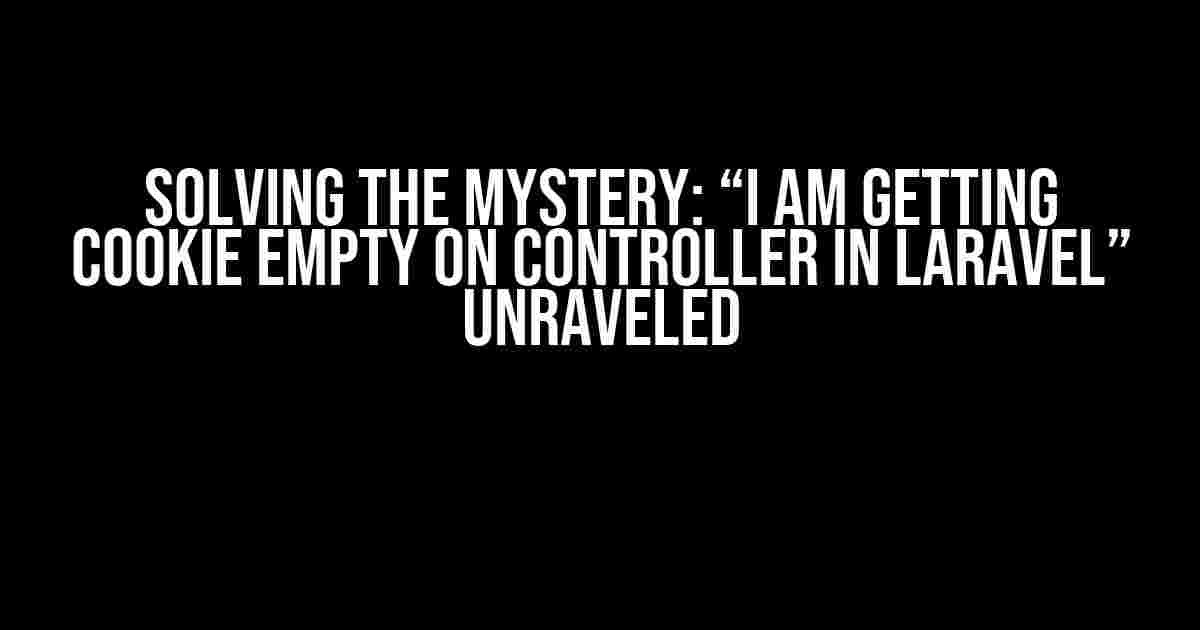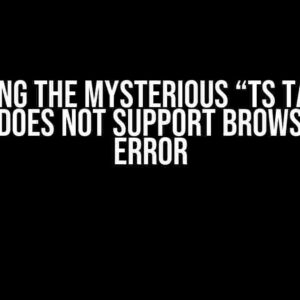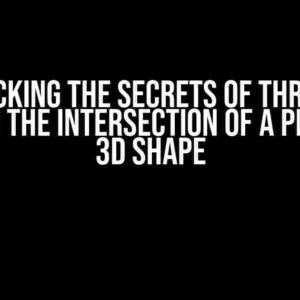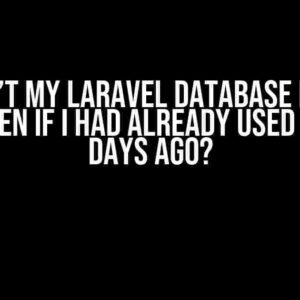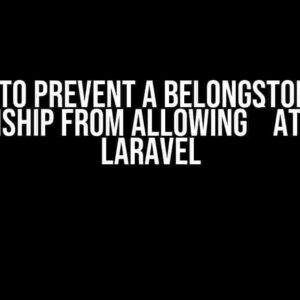Are you pulling your hair out trying to figure out why your Laravel controller is returning an empty cookie? Don’t worry, you’re not alone! In this article, we’ll dive into the world of Laravel cookies, explore the common pitfalls, and provide step-by-step solutions to get you back on track.
Understanding Laravel Cookies
Laravel provides a convenient way to set and retrieve cookies using the `Cookie` facade or the `request` object. But before we dive into troubleshooting, let’s quickly review how Laravel handles cookies:
- Laravel uses the `Set-Cookie` HTTP header to send cookies to the client.
- Cookies are encrypted and signed using the `encrypt` and `sign` methods, respectively.
- By default, Laravel sets cookies with a lifetime of 5 years (157680000 seconds).
Common Causes of Empty Cookies
Now that we’ve covered the basics, let’s explore the common reasons why you might be getting an empty cookie on your Laravel controller:
1. Misconfigured Cookie Settings
In your `config/session.php` file, ensure that the `cookie` section is properly configured:
'cookie' => [
'name' => 'laravel_session',
'lifetime' => 120,
'expire_on_close' => true,
'secure' => false,
'same_site' => 'lax',
],
Pay attention to the `lifetime` value, as it might be set to a very short duration, causing the cookie to expire immediately.
2. Inadequate Cookie Setting in Controller
When setting a cookie in your controller, make sure to use the correct syntax:
COOKIE::queue('cookie_name', 'cookie_value', 120);
or
$response->withCookie(cookie('cookie_name', 'cookie_value', 120));
Don’t forget to specify the correct lifetime (in minutes) and ensure that the cookie is not being overridden elsewhere in your code.
3. browser Cookie Settings
Check your browser’s cookie settings:
- Ensure that cookies are enabled.
- Verify that the cookie is not being blocked by a browser extension or plugin.
Troubleshooting Steps
Follow these step-by-step instructions to troubleshoot and resolve the issue:
-
Check the Laravel logs for any errors or warnings related to cookies.
tail -f storage/logs/laravel.log -
Verify that the cookie is being set correctly in your controller:
debug(Cookie::get('cookie_name')); -
Use the browser’s developer tools to inspect the HTTP response headers:
- Open the Developer Tools (F12 or Ctrl + Shift + I).
- Switch to the Network tab.
- Reload the page or make the request that sets the cookie.
- Find the response headers and look for the `Set-Cookie` header.
-
Verify that the cookie is being stored in the browser:
- Open the Developer Tools (F12 or Ctrl + Shift + I).
- Switch to the Application tab.
- Expand the Cookies section.
- Find the cookie and verify its value and expiration date.
Additional Tips and Best Practices
To avoid future cookie-related issues, keep the following tips in mind:
- Use a consistent naming convention for your cookies.
- Avoid setting cookies with very short lifetimes.
- Use the `secure` attribute to ensure cookies are sent over HTTPS.
- Consider using a token-based approach instead of cookies for sensitive data.
| Cookie Attribute | Description |
|---|---|
| `name` | The cookie name. |
| `value` | The cookie value. |
| `lifetime` | The cookie lifetime in minutes. |
| `secure` | Indicates whether the cookie should only be sent over HTTPS. |
| `same_site` | Specifies the same-site policy for the cookie. |
Conclusion
By following this comprehensive guide, you should now be equipped to troubleshoot and resolve the issue of getting an empty cookie on your Laravel controller. Remember to double-check your cookie settings, browser configuration, and Laravel logs to identify the root cause of the problem. If you’re still stuck, feel free to ask for help in the comments below!
Happy coding, and may your cookies be ever-filled!
Here are 5 Questions and Answers about “I am getting cookie empty on controller in Laravel”:
Frequently Asked Question
troubleshoot your Laravel application when cookies are not being set or retrieved correctly.
Question 1: Why am I getting an empty cookie in my Laravel controller?
This might be because you haven’t set the cookie in the first place! Make sure you’ve set the cookie using the `Cookie::queue` or `Cookie::make` method before trying to retrieve it in your controller. Double-check your code to ensure you’re setting the cookie correctly.
Question 2: I’ve set the cookie, but it’s still empty in my controller. What’s going on?
This could be due to the cookie not being sent with the request. Ensure that the cookie is being sent with the request by checking the headers or using a tool like Postman to inspect the request. Additionally, verify that the cookie is not being filtered out by any middleware or other components in your application.
Question 3: How can I access the cookie in my Laravel controller?
You can access the cookie using the `Cookie` facade or by injecting the `Illuminate\Http\Request` instance into your controller method. Use the `Cookie::get` method to retrieve the cookie value, like this: `Cookie::get(‘cookie_name’)`. Alternatively, use the `request()->cookie(‘cookie_name’)` syntax to access the cookie.
Question 4: Are there any security considerations I should keep in mind when working with cookies in Laravel?
Absolutely! Cookies can be vulnerable to security threats like cross-site scripting (XSS) and cookie tampering. Always use the `secure` and `httponly` flags when setting cookies to ensure they’re transmitted securely and can’t be accessed by JavaScript. Additionally, validate and sanitize user input to prevent XSS attacks.
Question 5: Can I use Laravel’s built-in cookie encryption to secure my cookies?
Yes, you can use Laravel’s built-in cookie encryption to secure your cookies. By default, Laravel encrypts cookies using the `App\Http\Middleware\EncryptCookies` middleware. This ensures that cookies are encrypted and decrypted automatically, providing an additional layer of security for your application.
I hope this helps! Let me know if you need any further assistance.

